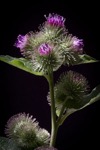| Scientific: | Arctium lappa |
|---|---|
| Other: | Burdock |
| Family: | Asteraceae |
Burdock is a common weed in temperate regions around the world, and is familiar to most outdoor enthusiasts because its seeds or “burrs” get stuck to clothes. The root is used in herbal medicine, and is also consumed as food (called Gobo) in Japanese cuisine.
Burdock is an important alterative or “blood cleanser,” used to treat chronic skin conditions like acne. It is believed to act as a detoxifier by promoting sweating, urination, and bile release from the liver. Its bitter compounds (sesquiterpene lactones) promote digestion and elimination of waste products and it has been used for bloating and indigestion.
It also contains compounds called lignins (similar to what are found in flax seeds) and these compounds have phytoestrogenic effects.
Burdock is one of four herbs in the traditional anticancer herbal formula “Essiac”. Although no clinical trials have been performed to date measuring the efficacy of the formula against cancer, some preclinical trials suggest that burdock does possess some anticancer properties.
Dermatologic
• chronic skin conditions
• acne
• psoriasis
• eczema
Gastrointestinal
• digestive complaints
• dyspepsia
• hypochlorhydria
Hepatobiliary
• biliary insufficiency
• cholestasis
• cholelithiasis (gallstones)
• jaundice
Musculoskeletal
• chronic rheumatic conditions
• arthritis
• gout
• Alterative
• Bitter
• Stomachic
• Cholagogue
• Choleretic
• Antimicrobial
• Diuretic
• Laxative (Mild )
• Sesquiterpene Lactones (E.g. Atricol)
• Flavonoids
• Lignins (E.g. Arctigenin)
• Inulin (Roots)
• Phenoilc Acids
• Polyacetylenes
• Tannins
• Tincture (1:5 in 40% EtOH): 2-4 ml tid
• Liquid extract (1:1 in 25% EtOH): 2-6 ml tid
• Decoction (dried herb): 1 tsp g tid
Generally considered safe when used as indicated.
Barnes J, Anderson LA, Phillipson JD. Herbal Medicines, 3rd ed. London: Pharmaceutical Press, 2007.
Bone K. Principles and Practice of Phytotherapy. Edinburgh: Churchill Livingstone, 2000.
Bone K. A Clinical Guide to Blending Liquid Herbs: Herbal Formulations for the Individual Patient. St Louis, MO: Churchill Livingstone, 2003.
Brinker F. The Toxicology of Botanical Medicines, 3rd ed. Sandy, Oregon: Eclectic Medical Publications, 2000.
Felter HW, Lloyd JU. King's American Dispensatory. 1898. http://www.ibiblio.org/herbmed/eclectic/kings/main.html. Accessed: August 19, 2006.
Hoffman D. Medical Herbalism. Rochester, Vermont: Healing Arts Press, 2003.
Weiss RF. Herbal Medicine. Beaconsfield, England: Beaconsfield Publishers Ltd, 1988.
Williamson EM, ed. Major Herbs of Ayurveda. Edinburgh: Churchill Livingstone, 2002
Disclaimer: This content is subject to change. The information is intended to inform and educate; it does not replace the medical evaluation, advice, diagnosis or treatment by a healthcare professional. www.nhpassist.com © 2014 NDAssist Inc. and/or its affiliates. All rights reserved.

|
Burdock
SummaryBurdock is a common weed in temperate regions around the world, and is familiar to most outdoor enthusiasts because its seeds or “burrs” get stuck to clothes. The root is used in herbal medicine, and is also consumed as food (called Gobo) in Japanese cuisine. IndicationsSign in requiredActionsSign in requiredConstituentsSign in requiredPosologySign in requiredSafetySign in requiredReferencesSign in required |
|---|